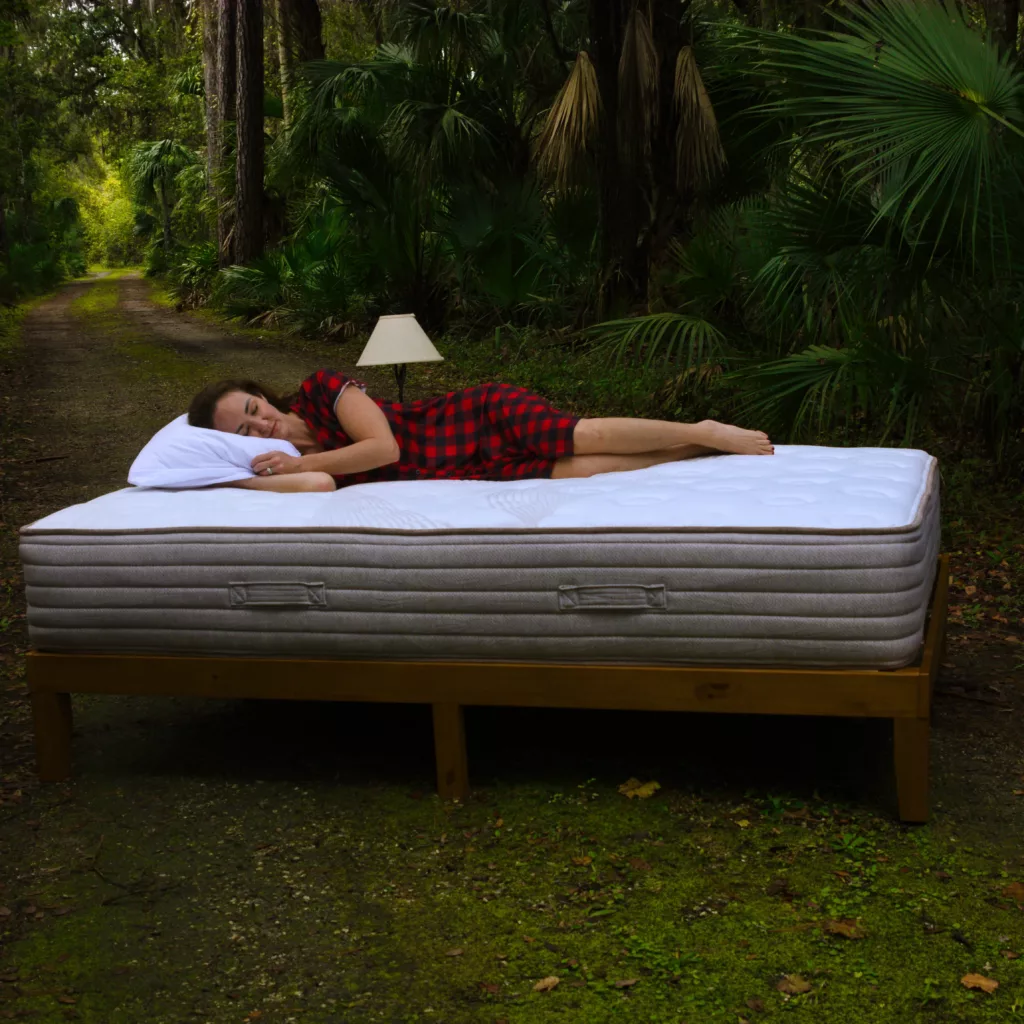Choosing the right firmness level for your mattress isn’t just about comfort—it’s about improving sleep quality, supporting your body, and promoting long-term wellness. At SolaPedic, we make that choice easier by offering three distinct firmness levels across our EcoChoice Affordable Organic Mattress and VerdeChoice Organic Mattress collections: Plush, Medium, and Firm. Each is crafted with certified organic materials like HelioFlex Natural Latex, GOTS-Certified Radiance Wool, and LuminLuxe Organic Cotton Quilting. Here’s a clear, simple guide to help you choose the firmness level that suits your sleep style.
How Firmness Varies Across Our Collections
Each SolaPedic mattress collection offers different firmness options tailored to its design:
EcoChoice Affordable Organic Mattress:
Available in Firm, Medium, and Plush. Ideal for budget-conscious shoppers looking for healthier sleep without compromise.VerdeChoice Organic Mattress:
Available in Firm, Medium, and Plush. A mid-range option for those wanting customized comfort paired with premium natural materials.EmeraldChoice Latex Mattress:
Available exclusively in Medium firmness. Our luxury model offers balanced support and plush latex responsiveness, perfect for shoppers seeking a premium feel.
Understanding Firmness Levels
Plush (Firmness Level 3)
Our softest option, Plush offers a cloud-like, cushioned feel with ample give under your body weight. It’s ideal for those seeking gentle contouring and pressure relief.Medium (Firmness Level 5–6)
Often considered the universal comfort level, Medium firmness strikes a balance between softness and support. It adapts to a wide range of sleepers and is especially popular with couples who have different sleep preferences.Firm (Firmness Level 7–8)
Firm provides the least give and the most support. It’s designed for those who prefer a solid, stable sleep surface that keeps the body aligned without sinking in.
Consider Your Sleeping Position
Your preferred sleep position is one of the biggest factors in choosing the right firmness level. Different positions place varying pressure on specific areas of your body, which is why the right firmness level can make all the difference in spinal alignment, pressure relief, and overall sleep comfort.
Side Sleepers:
Typically benefit from the Plush option. It allows for better contouring around the shoulders and hips, reducing pressure points and promoting proper spinal alignment. Side sleepers who experience hip or shoulder pain may find the additional softness especially beneficial. For those who prefer a balance of softness and support, Medium firmness can also be a comfortable alternative.Back Sleepers:
Often prefer Medium firmness. It supports the natural curve of the spine while providing just enough cushioning to stay comfortable. Back sleepers require a mattress that keeps the lower back supported without letting the hips sink in too deeply. A Medium firmness ensures even weight distribution and reduces the risk of lower back discomfort.Stomach Sleepers:
Generally do best with a Firm mattress. It prevents the hips from sinking too deeply, which helps maintain spinal alignment and reduces lower back strain. Stomach sleepers often experience discomfort if their mattress is too soft, as this can cause their midsection to dip and create tension in the back and neck. A firmer surface provides the right level of lift and support.

Body Weight and Firmness
Body weight also plays a major role in how a mattress feels. The way your body interacts with the mattress surface changes depending on how much pressure you apply, affecting both support and comfort levels.
Lighter Sleepers (Under 130 lbs):
Often prefer Plush. The softer feel provides enough give to contour and support lighter frames without feeling too hard or unyielding. Lighter individuals may find firmer mattresses uncomfortable due to insufficient sinkage, leading to increased pressure points, especially around the hips and shoulders.Average Weight Sleepers (130–230 lbs):
Medium firmness usually feels most balanced—supportive without being too hard or too soft. Sleepers in this range generally experience an even balance of contouring and support across Plush, Medium, or Firm options, though Medium is often the preferred starting point for testing comfort.Heavier Sleepers (Over 230 lbs):
Tend to need Firm for optimal support. A firmer mattress prevents excessive sinkage, helping maintain posture and long-term comfort. Heavier sleepers benefit from firmer mattresses to avoid bottoming out through softer layers, which can lead to poor spinal alignment and reduced mattress durability.
Additionally, couples with significantly different body weights may prefer a Medium firmness as a compromise, or consider a split firmness setup where each partner can choose their ideal level of comfort.

Health Considerations
Health concerns and physical needs can guide your firmness choice in meaningful ways. Choosing the right firmness level is not just about comfort; it can have a significant impact on managing or improving certain health conditions.
Back Pain:
Medium firmness offers balanced support and comfort, making it a popular choice for back pain relief. It provides the necessary spinal alignment without creating pressure points. A mattress that is too soft can allow the lower back to sag, while one that is too firm may not provide enough give, both of which can exacerbate back issues.Joint Pain or Arthritis:
Plush firmness can help by offering extra cushioning around sensitive joints, especially in the shoulders and hips. The added softness reduces pressure on inflamed or painful areas. For arthritis sufferers, it is also important to consider a mattress that offers easy mobility when changing positions to avoid stiffness.Sciatica or Nerve Pain:
A Medium to Firm mattress is often recommended for individuals dealing with sciatica or other nerve-related discomforts. Firm support helps maintain a neutral spine position, reducing pressure on the sciatic nerve or related areas.Post-Surgery Recovery:
People recovering from surgery may benefit from a Plush to Medium firmness, depending on the type of surgery. Softer surfaces can relieve pressure points during extended bed rest, while still providing enough support to avoid misalignment.Sleep Apnea or Snoring:
While not directly related to firmness, back sleepers with sleep apnea may find better results using a Medium to Firm mattress that supports an elevated sleeping position with less sinkage, especially when combined with adjustable bases.Pregnancy:
Pregnant individuals often find side sleeping more comfortable, especially in the later stages of pregnancy. A Plush to Medium mattress can help provide necessary cushioning and support around the hips and belly without creating additional pressure points.Pressure Sores (Bedsores):
For those who are bedridden or at risk of pressure sores, Plush mattresses can help distribute weight more evenly and reduce localized pressure. However, material quality is crucial—SolaPedic’s certified organic materials provide breathable comfort and reduce moisture buildup, which also helps in skin health.
Always remember, health recommendations are general guidance. It’s important to consult a healthcare professional for specific medical advice regarding your sleep setup.

Personal Preference and Comfort
Beyond sleeping position and weight, comfort is subjective. Some people simply prefer a firmer or softer feel, no matter what the “guidelines” suggest. That’s why SolaPedic always encourages customers to trust their own comfort instincts—there’s no one-size-fits-all answer.
Your body may respond differently to firmness based on factors like sleep habits, daily activities, or stress levels. For example, someone who engages in physically demanding work may prefer a mattress that feels more supportive to help with recovery, while someone seeking relaxation after long hours at a desk may gravitate toward a softer, more cushioning surface.
Temperature preferences can also influence firmness choices. Firmer mattresses often feel cooler because there is less sinkage and therefore less material wrapping around the body, while plusher mattresses may retain a bit more warmth due to increased contouring.
Even aesthetic and tactile preferences matter. Some sleepers enjoy the feeling of sleeping “on” a mattress (associated with firmer options) while others prefer the sensation of sleeping “in” a mattress (typically found with plush firmness). These small details play into the overall sleep experience and should be considered alongside functional factors like sleep position and weight.
Finally, it’s worth noting that your ideal firmness level can evolve over time. Changes in age, health conditions, lifestyle, or even simply trying a new mattress can shift your preferences. That’s why SolaPedic offers a 100-night sleep trial—so you have time to truly decide what feels best for you.

The Quality of Materials Matters Too
At SolaPedic, firmness is only part of the equation. All our mattresses—including EcoChoice and VerdeChoice—are made with premium, certified organic materials:
GOTS-Certified Radiance Wool for natural temperature regulation
HelioFlex Natural Latex for responsive support
LuminLuxe Organic Cotton Quilting for breathable comfort
No toxins, no flame-retardant chemicals, and no fillers—just honest materials for healthier sleep.
Not Sure Yet? Try It Yourself
We know choosing firmness is personal. That’s why every SolaPedic mattress comes with a 100-night sleep trial and up to a 20-year warranty. Sleep on it, live with it, and see if it’s truly right for you. And don’t forget—veterans and first responders receive a 35% discount, the largest in the industry.
